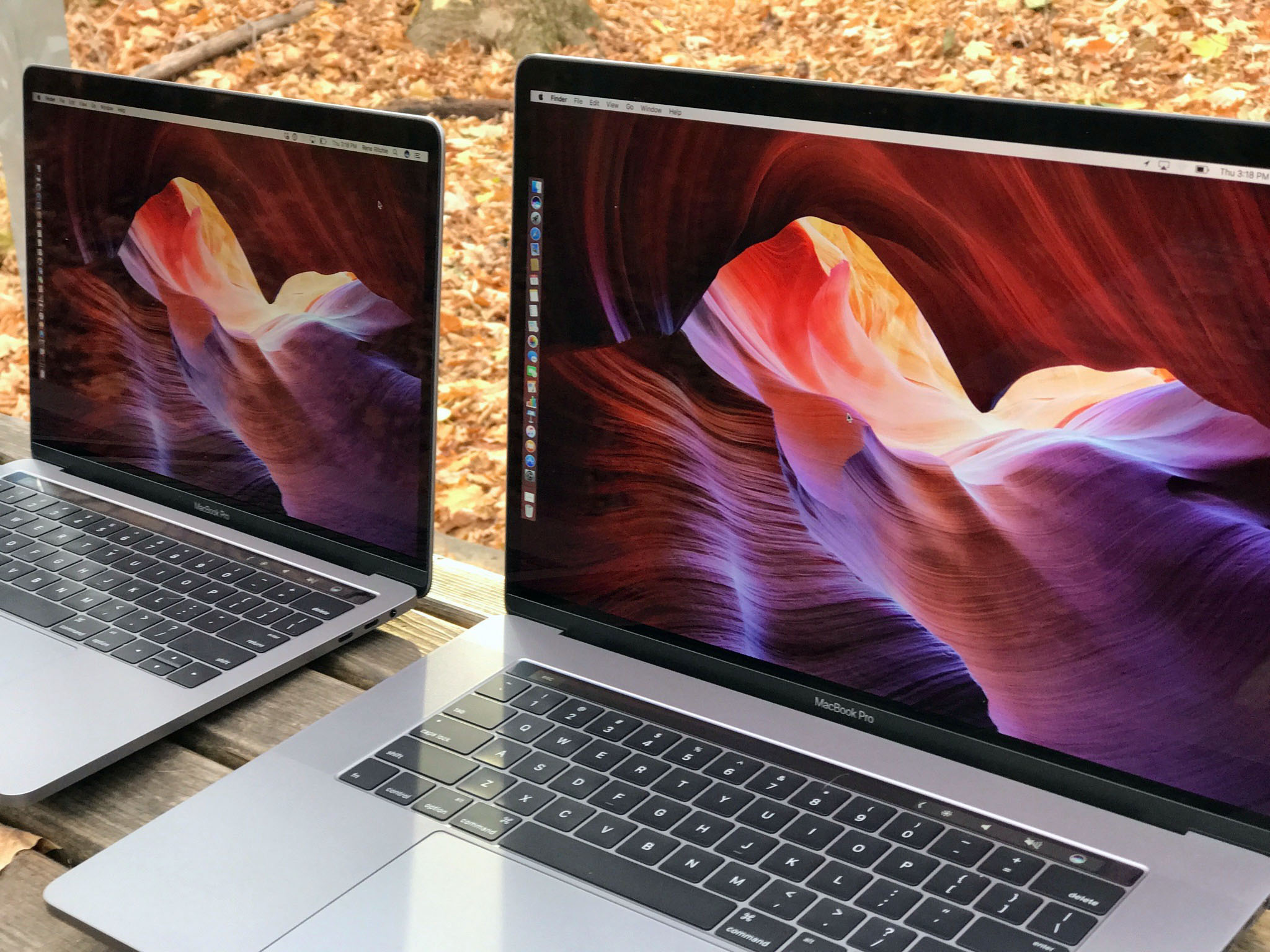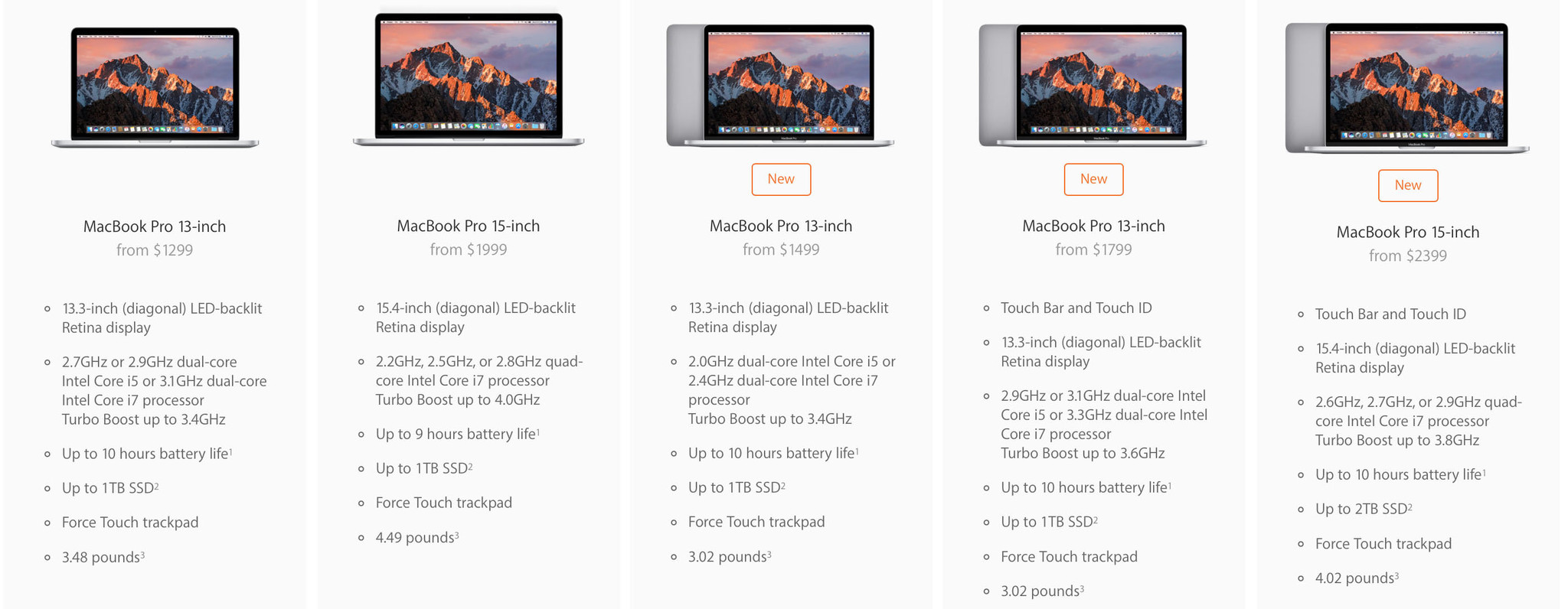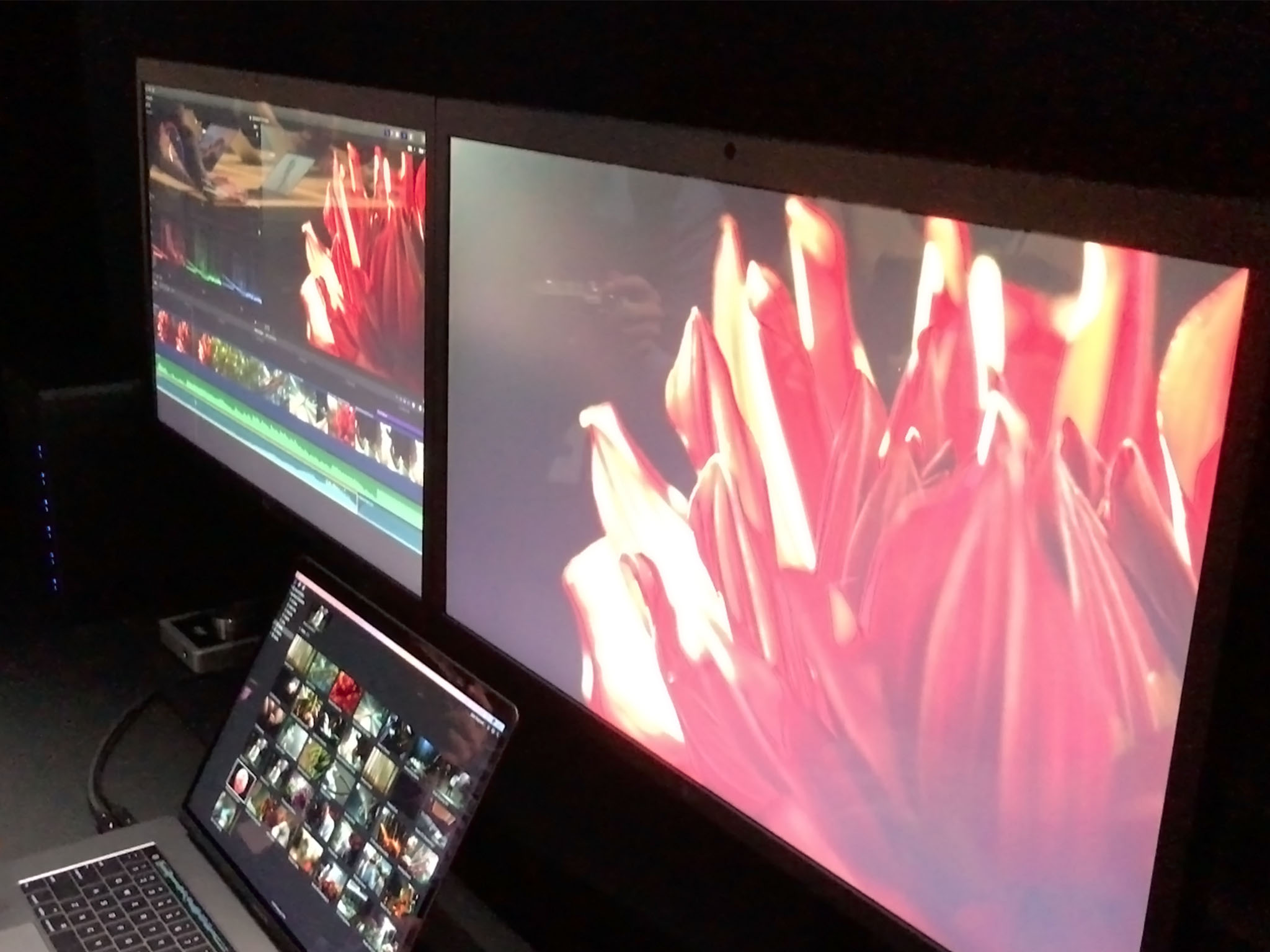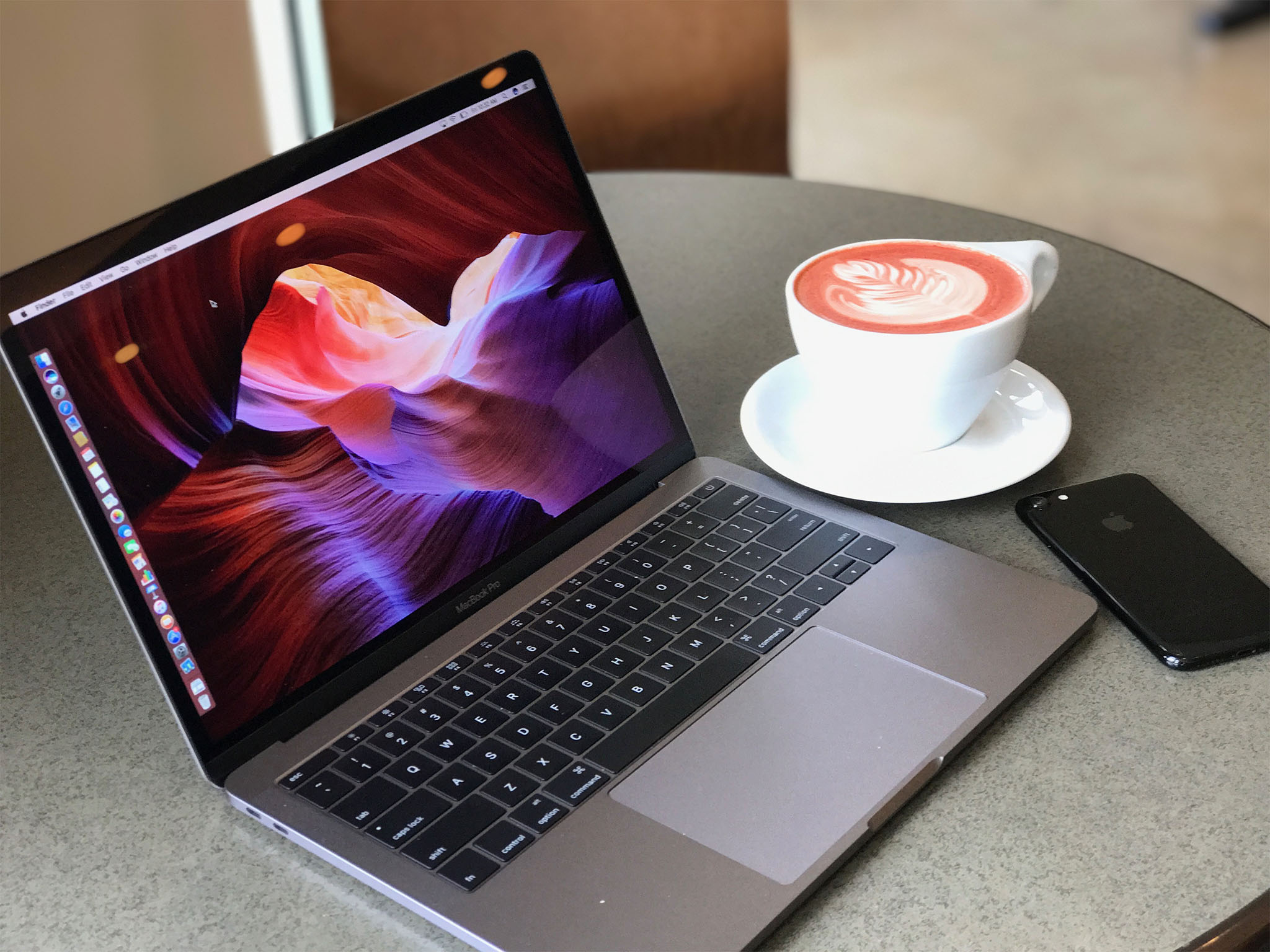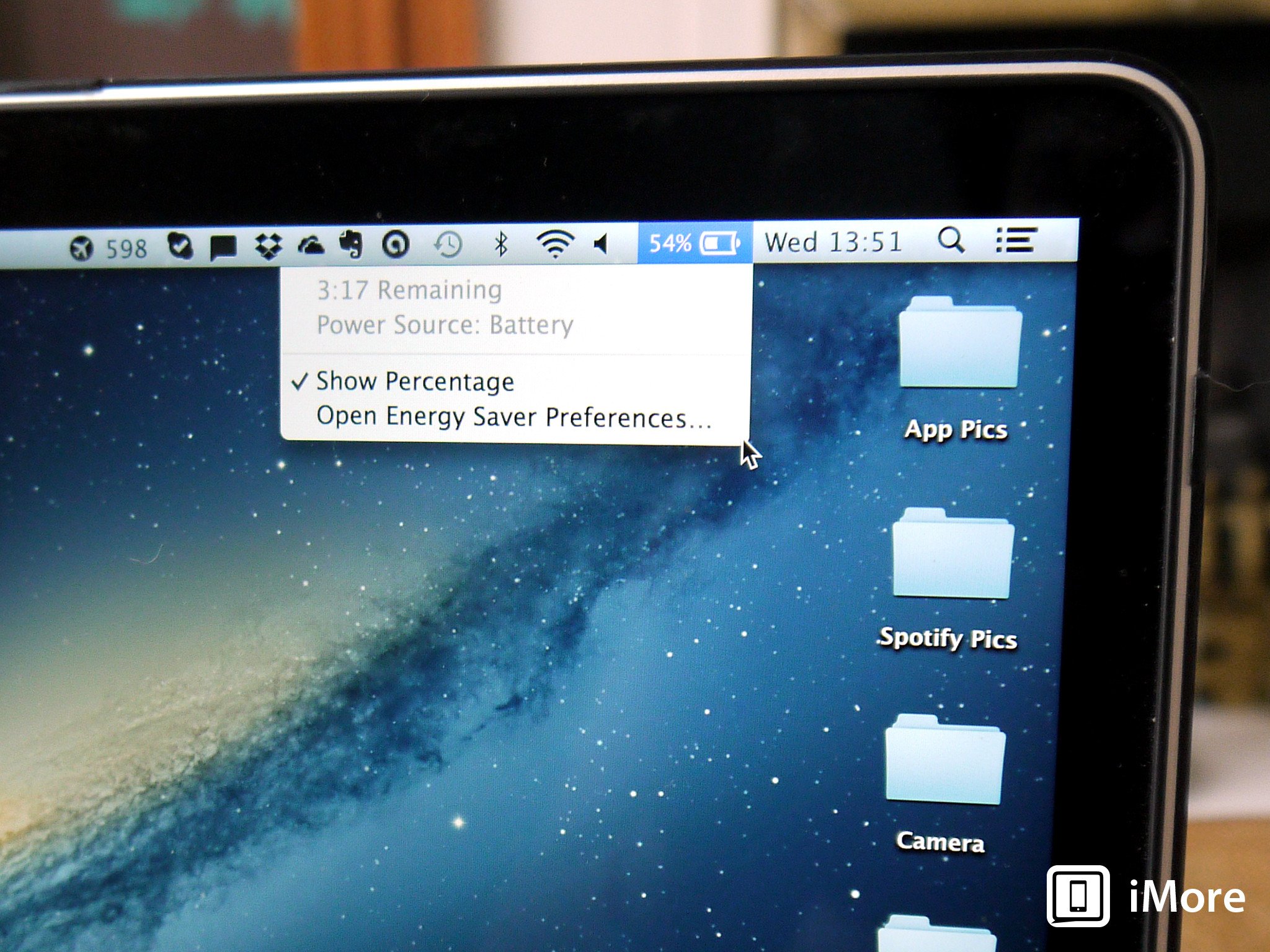Should you buy the 13-inch or 15-inch MacBook Pro?
- apr
- 28
- Posted by Michael
- Posted in Okategoriserade
Should you buy the 13-inch or 15-inch MacBook Pro? Here's how to choose!
Apple currently offers the MacBook Pro in two sizes: 13-inch and 15-inch. They differ in ways beyond simply display size though, including the overall weight and footprint, and details of the ports and the potential of their processors. So, how do you decide between them?
See our pick for the best Apple laptop.
MacBook Pro lineup
If you look at Apple's current MacBook Pro lineup, even excluding the 12-inch MacBook and legacy 13-inch MacBook Air, there's still a ton to choose from. Especially when you consider Apple still offers last year's MacBook Pro 13-inch and 15-inch alongside this year's models.
For this, I'll be referring to the 2016 MacBook Pro, though many of the points will also pertain to 2015 pros as well.
Weight and size
With great size comes great weight. Or something like that. What I mean is, those extra 2-inches (diagonal) of display come with a bigger footprint, which means your MacBook Pro will take up more room on the table, from your desk to the coffee shop to the tray on the train or airplane.
It'll also weigh more in your laptop bag. The 13-inch MacBook Pro weighs 3.02 pounds (1.37 kg). The 15-inch MacBook Pro weighs 4.02 pounds (1.83 kg). That might not sound like a huge difference, but if you're walking around all day, it might just feel like one.
- If portability is most important to you, get the 13-inch MacBook Pro.
- If power beats portability, get the 15-inch MacBook Pro.
Displays
MacBook Pro was the first Mac to go "Retina", or what Apple calls a display dense enough that you can no longer see pixels at a normal working distance. They remain Retina to this day so, no matter which one you get, the quality will be the same. What about the quantity, though?
The 13-inch MacBook Pro has a 2560x1600 16:10 display at 227 ppi. The 15-inch MacBook Pro has a 2880x1800 16:10 display at 220 ppi.
More display means seeing either more of the web and more of apps you can cram onto it, including interface and toolbars. Or, if accessibility is an issue, seeing bigger of all the same.
Here's how the pixel differences look side-by-side:
- If size doesn't matter to you, save some space and dollars and get the 13-inch MacBook Pro.
- If you want the largest possible display, you want the 15-inch MacBook Pro.
External displays
You can also drive external displays with the MacBook Pro. Due to a difference in the bandwidth supplied to the Thunderbolt 3 ports on both sides of the 2016 MacBook Pro, however, you can't drive as many on the 13-inch. Specifically, the 13-inch MacBook Pro can support up to two 4096x2304 (4K) or one 5120x2880 (5K) display. The 15-inch MacBook Pro, though, can drive up to four 4096x2304 (4K) or two 5120x2880 (5K) displays.
- If you don't need an external display, or one need a one or two, the 13-inch is fine.
- If you want to drive four 4K or two 5K external displays, you want a 15-inch MacBook Pro 2016.
Processors
The central processing unit (CPU) is what powers the MacBook Pro. MacBook Pro 2016 has Intel's Skylake processors for both the 13-inch and 15-inch models.
The 13-inch model starts with a 2.0GHz dual-core Intel Core i5 or 2.4GHz dual-core Intel Core i7 processor for the version without the Touch Bar, and 2.9GHz or 3.1GHz dual-core Intel Core i5, or 3.3GHz dual-core Intel Core i7 processor for the version with Touch Bar.
The 15-inch has options for a 2.6GHz, 2.7GHz, or 2.9GHz quad-core Intel Core i7 processor.
- If absolute power doesn't matter, don't give Intel any more money and stick with the 13-inch MacBook Pro.
- If you want maximum performance for things like video editing, you want a quad-core 15-inch MacBook Pro.
Graphics
The graphics processing unit (GPU) handles rendering and pushing the pixels. That includes everything from the macOS interface to photo and video editors to video games. The more powerful the GPU, the more pixels it can render and push, and the smoother and better the animations, apps, and the more realistic 3D you'll get.
MacBook Pro 2016 has Intel Iris Graphics 540 for the 13-inch version without Touch Bar and Intel Iris Graphics 550 for the 13-inch version with Touch Bar. The 15-inch version has both Intel HD Graphics 530 for low power and discreet graphics for high performance.
There are options for Radeon Pro 450 with 2GB of GDDR5 or 460 with 4GB of GDDR5 on the 13-inch model, or Radeon Pro 455 with 2GB of GDDR5 or Radeon Pro 460 with 4GB of GDDR5 on the 15-inch model.
- If you graphics needs are casual at best, the 13-inch MacBook Pro can save you some cach.
- If you want the biggest graphics boost you can get, you want the 15-inch MacBook Pro.
Battery Life
All versions of the MacBook Pro 2016 are rated for 10-hours of web browsing or iTunes movie playback and 30 days on standby. (iTunes movie playback is hardware accelerated, so YouTube in Chrome will consume way more power, for example.)
Those are for base models, though. The higher the processor and graphics options you get, and the harder you push them, the less battery life you'll get.
- Battery life is pretty much the same on all models, just know that the more and hotter you push them, the more you'll have to charge them.
Memory
The amount of random access memory (RAM) in your Mac determines how many apps you can keep live at a time, how big your photo or video editing projects can be without having to swap data out back and forth on the drive, and otherwise keeps everything super fast.
The 13-inch MacBook Pro 2016 without Touch Bar starts with 8GB of 1866MHz LPDDR3 memory and can go to 16GB. The 13-inch MacBook Pro 2016 with Touch Bar starts at 8GB of 2133MHz LPDDR3 memory and can go to 16GB. The 15-inch MacBook Pro 2016 only comes with 16GB of 2133MHz LPDDR3 memory.
- If you don't want 16 GB of RAM, you need to go 13-inch MacBook Pro.
- All MacBooks Pro currently max out at 16 GB, so if that's what you want, get any MacBook Pro you want.
Storage
Storage used to consist of big, noisy hard drive platters that spun around and didn't take well to bumps or power problems. Now they're solid state — Flash chips with no moving parts. They don't hold as much as old-style hard drives and are still more expensive, but they're ultra-fast and far more resilient.
The 13-inch MacBook Pro 2016 comes with 256GB PCIe Flash storage but can go up to 1 TB. The 15-inch MacBook Pro 2016 starts with 256GB PCI Flash storage on the low-end model, 512GB PCIe Flash storage on the high-end model, and both can go to 2 TB.
- If you want the largest amount of storage possible — 2 TB — you want the 15-inch MacBook Pro 2016.
Ports
Wired connections like USB-C and Thunderbolt 3 let you connect to high-performance accessories like external displays, drives, networks, and more.
The 13-inch MacBook Pro 2016 without the Touch Bar has 2x Thunderbolt 3 ports (USB-C), both the 13- and 15-inch MacBook Pro 2016 with the Touch Bar have 4x Thunderbolt 3 ports (USB-C), though the two right ports on the 13-inch aren't full speed.
- If you want the most, fastest ports possible, you want the 15-inch MacBook Pro.
Who should get the 13-inch MacBook Pro 2016?
If you value portability over power, don't need to drive double the displays, are fine with fewer processor cores and lower end memory and graphics options, and otherwise want a pro without paying top dollar for it, get a 13-inch MacBook Pro.
Who should get the 15-inch MacBook Pro 2016?
If you want power, the biggest display possible, the ability to drive ridiculous amounts of external display, and options for the most memory, processor cores, and graphics chips availale, you want the 15-inch MacBook Pro.
Still undecided?
If you're still having trouble choosing which MacBook Pro is for you, make sure to pay our Apple notebooks discussion forums a visit. Once you've decided, let me know what you got!
Senaste inläggen
- iOS 18 might add AI-powered Messages summary feature for your friends who text too much
- Apple boss says it has ”advantages that will differentiate” its AI push
- Apple celebrates May 4th with fun new Star Wars ad for ’Find Your Friends’
- Ny video från Apple – med tema från Star Wars
- Apple’s May 7 iPad Pro and Air event won’t include the rumored AI announcement, and nor should it
Senaste kommentarer
Arkiv
- maj 2024
- april 2024
- mars 2024
- februari 2024
- januari 2024
- december 2023
- november 2023
- oktober 2023
- september 2023
- augusti 2023
- juli 2023
- juni 2023
- maj 2023
- april 2023
- mars 2023
- februari 2023
- januari 2023
- december 2022
- november 2022
- oktober 2022
- september 2022
- augusti 2022
- juli 2022
- juni 2022
- maj 2022
- april 2022
- mars 2022
- februari 2022
- april 2021
- mars 2021
- januari 2021
- december 2020
- november 2020
- oktober 2020
- september 2020
- augusti 2020
- juli 2020
- juni 2020
- maj 2020
- april 2020
- mars 2020
- februari 2020
- januari 2020
- december 2019
- november 2019
- oktober 2019
- september 2019
- augusti 2019
- juli 2019
- juni 2019
- maj 2019
- april 2019
- mars 2019
- februari 2019
- januari 2019
- december 2018
- november 2018
- oktober 2018
- september 2018
- augusti 2018
- juli 2018
- juni 2018
- maj 2018
- april 2018
- mars 2018
- februari 2018
- januari 2018
- december 2017
- november 2017
- oktober 2017
- september 2017
- augusti 2017
- juli 2017
- juni 2017
- maj 2017
- april 2017
- mars 2017
- februari 2017
- januari 2017
- december 2016
- november 2016
- oktober 2016
- september 2016
- augusti 2016
- juli 2016
- juni 2016
- maj 2016
- april 2016
- mars 2016
- februari 2016
- januari 2016
- december 2015
- november 2015
- oktober 2015
- september 2015
- augusti 2015
- juli 2015
- juni 2015
- maj 2015
- april 2015
- mars 2015
- februari 2015
- januari 2015
- december 2014
- november 2014
- oktober 2014
- september 2014
- augusti 2014
- juli 2014
- juni 2014
- maj 2014
- april 2014
- mars 2014
- februari 2014
- januari 2014
Kategorier
- –> Publicera på PFA löp
- (PRODUCT) RED
- 2015
- 25PP
- 2nd gen
- 32gb
- 3D Touch
- 3D-kamera
- 4k
- 64gb
- 9to5mac
- A10
- A9X
- Aaron Sorkin
- Accessories
- adapter
- AirPlay
- AirPods
- Aktiv
- Aktivitetsarmband
- Aktuellt
- Alfred
- AMOLED
- Android Wear
- Angela Ahrendts
- Ångerätt
- announcements
- Ansiktsigenkänning
- app
- App Store
- Appar
- Apple
- Apple Beta Software Program
- Apple Book
- Apple CarPlay
- Apple Event
- Apple iMac
- Apple Mac Mini
- Apple Macbook
- Apple MacBook Air
- Apple MacBook Pro
- Apple Macos
- Apple Maps
- Apple Music
- Apple Music Festival
- Apple Music Radio
- Apple Offer
- Apple Online Store
- Apple Park
- Apple Pay
- Apple Pencil
- Apple Podcast
- Apple Store
- Apple Store 3.3
- Apple TV
- apple tv 4
- Apple TV 4K
- Apple Watch
- Apple Watch 2
- Apple Watch 8
- Apple Watch 9
- Apple Watch Apps
- Apple Watch SE
- Apple Watch Series 2
- Apple Watch Sport
- Apple Watch Ultra
- AppleCare
- AppleTV
- Application
- Applications
- Apps
- AppStore
- Apptillägg
- Apptips
- AppTV
- April
- Arbetsminne
- armband
- Art Apps
- Återköp
- återvinning
- Åtgärdsalternativ
- atvflash
- Audio Apps
- Augmented REality
- Back-to-school
- Bakgrundsbilder
- BankId
- Barn
- Batteri
- batteriskal
- batteritid
- Beats
- Beats 1
- Beats Solo 2 Wireless
- Beats Solo2
- Bebis
- Beginner Tips
- Belkin
- Bendgate
- beta
- Beta 3
- betaversion
- betaversioner
- bilddagboken.se
- bilder
- bilhållare
- billboard
- Bioteknik
- Blendtec
- Bloomberg
- Bloons TD 5
- Bluelounge
- Bluetooth
- Böj
- Booking.com
- Borderlinx
- bose
- bugg
- Buggar
- Buggfixar
- Butik
- C More
- Calc 2M
- Camera
- Campus 2
- Canal Digital
- Carpool Karaoke
- Caseual
- Catalyst
- CES 2015
- Chassit
- Chip
- Chrome Remote Desktop
- Chromecast
- citrix
- clic 360
- CNBC
- Connect
- Cydia
- Dagens app
- Dagens tips
- Damm
- Danny Boyle
- Data
- datamängd
- Datorer
- Datortillbehör
- Datum
- Defense
- Dekaler
- Designed by Apple in California
- Developer
- Development
- Digital Inn
- Digital Touch
- Digitalbox
- DigiTimes
- Direkt
- Discover
- display
- DisplayMate
- Dive
- Docka
- Dräger 3000
- Dropbox
- Droples
- DxOMark
- E-post
- earpod
- EarPods
- Earth Day
- Eddie Cue
- eddy cue
- Educational Apps
- Ekonomi
- Ekonomi/Bransch
- El Capitan
- Elements
- ElevationLab
- Elgato Eve
- Elgato Eve Energy
- EM 2016
- Emoji
- emojis
- emoticons
- Enligt
- EU
- event
- Eventrykten
- EverythingApplePro
- Faceshift
- facetime
- Fäste
- Featured
- Features
- Feng
- Film / Tv-serier
- Filmer
- Filstorlek
- Finance Apps
- Finder For AirPods
- Finland
- FireCore
- Fitbit
- Fitness Accessories
- Fjärrstyr
- Flurry
- Födelsedag
- fodral
- Förboka
- Force Touch
- förhandsboka
- Första intryck
- Forumtipset
- foto
- FoU (Forskning och Utveckling)
- Fource Touch
- Foxconn
- FPS Games
- Framtid
- Fre Power
- Frontpage
- Fullt
- Fuse Chicken
- Fyra
- Gadgets
- Gagatsvart
- Gamereactor
- Games
- Gaming
- Gaming Chairs
- Gästkrönika
- General
- Gigaset
- Gitarr
- Glas
- GM
- Google Maps
- Google Now
- gratis
- grattis
- Guide
- Guider
- Guider & listor
- Guld
- hack
- Halebop
- hållare
- Hälsa
- Hårdvara
- HBO
- HBO Nordic
- Health
- Health and Fitness
- Health and Fitness Apps
- Hej Siri
- Helvetica Neue
- Hemelektronik
- Hemknapp
- Hemlarm
- Hermes
- Hitta min iphone
- Hjärta
- högtalare
- HomeKit
- HomePod
- hörlurar
- htc
- Hue
- Humor
- i
- I Am A Witness
- IBM
- iBolt
- iBomber
- iBook
- icar
- iCloud
- iCloud Drive
- iCloud Voicemail
- iCloud.com
- iDevices
- IDG Play
- idownloadblog
- iFixit
- ikea
- iKörkort
- iLife
- Illusion Labs
- iMac
- IMAP
- iMessage
- iMessages
- iMore Show
- Incipio
- InFuse
- Inspelning
- Instagram-flöde
- Instrument
- Intel
- Internet/Webbtjänster
- iOS
- iOS 10
- iOS 12
- iOS 17
- iOS 18
- iOS 5
- iOS 7
- iOS 8
- iOS 8 beta
- iOS 8.1.3
- iOS 8.2
- iOS 8.3
- iOS 8.4
- iOS 8.4.1
- iOS 9
- iOS 9 beta 4
- iOS 9.1
- iOS 9.1 beta 2
- iOS 9.2
- iOS 9.2.1
- iOS 9.3
- IOS Games
- ios uppdatering
- ios9
- iPad
- iPad Accessories
- iPad Air
- iPad Air 2
- iPad Air 3
- iPad Apps
- iPad Mini
- iPad mini 4
- iPad Mini 6
- iPad mini retina
- iPad Pro
- iPados
- iphone
- iPhone 12
- iPhone 14
- iPhone 14 Pro
- iPhone 15
- iPhone 16
- iPhone 17
- iPhone 5
- iPhone 5S
- iPhone 5se
- iPhone 6
- iphone 6 plus
- iPhone 6c
- iPhone 6s
- iPhone 6S plus
- iPhone 7
- iPhone 7 display
- iPhone 7 Plus
- iPhone 7s
- iPhone Accessories
- iPhone Apps
- iPhone SE
- iphone x
- iPhone XS
- iPhone XS Max
- iPhone7
- iPhoneGuiden
- iPhoneguiden.se
- iPhones
- iPod
- iPod Nano
- iPod shuffle
- ipod touch
- iSight
- iTunes
- iWatch
- iWork
- iWork för iCloud beta
- Jailbreak
- James Corden
- Jämförande test
- Jämförelse
- Jet Black
- Jet White
- Jönssonligan
- Jony Ive
- Juice Pack
- Juridik
- Just mobile
- kalender
- kalkylator
- Kamera
- Kameratest
- Karriär/Utbildning
- Kartor
- Kevin Hart
- keynote
- Keynote 2016
- KGI
- KGI Security
- Kina
- Klassiskt läderspänne
- Kod
- Kollage
- koncept
- konceptbilder
- köpguide
- krasch
- Krascha iPhone
- Krönika
- Kvartalsrapport
- Laddhållare
- laddningsdocka
- Laddunderlägg
- läderloop
- lagar
- Lagring
- Lajka
- Länder
- lansering
- laserfokus
- Layout
- leather loop
- LG
- Liam
- Lifeproof
- Lightnigport
- lightning
- Linux
- LinX
- live
- Live GIF
- Live Photos
- Live-event
- Livsstil
- Ljud & Bild
- Logitech
- LOL
- Lösenkod
- Lösenkodlås
- Lovande spel
- LTE
- Luxe Edition
- M3
- M3TV
- Mac
- Mac App Store
- Mac Apps
- Mac Mini
- Mac OS
- Mac OS X
- Mac OS X (generellt)
- Mac OS X Snow Leopard
- Mac Pro
- Macbook
- Macbook Air
- Macbook Pro
- Macforum
- Macintosh
- macOS
- Macs
- MacWorld
- Made for Apple Watch
- magi
- Magic
- MagSafe
- Martin Hajek
- matematik
- Meddelanden
- Media Markt
- Medieproduktion
- Mediocre
- Messaging Apps
- Messenger
- MetaWatch
- Mfi
- Michael Fassbender
- microsoft
- Mikrofon
- Minecraft
- Ming-Chi Kuo
- miniräknare
- minne
- Mixer
- Mixning
- Mjukvara
- mobbning
- Mobile Content
- Mobilt
- Mobilt/Handdator/Laptop
- Mobiltelefon
- Mockup
- Mophie
- mors dag
- moto 360
- Motor
- MTV VMA
- multitasking
- Music
- Music Apps
- Music, Movies and TV
- Musik
- Musikmemon
- MW Expo 2008
- native union
- Nätverk
- Navigation Apps
- nedgradera
- Netatmo Welcome
- Netflix
- Netgear Arlo
- News
- Niantic
- Nike
- Nikkei
- Nintendo
- Nöje
- Norge
- Notis
- Notiscenter
- nya färger
- Nyfödd
- Nyheter
- Officeprogram
- Okategoriserade
- OLED
- omdöme
- Omsättning
- OS X
- OS X El Capitan
- OS X Mavericks
- OS X Yosemite
- Outlook
- Övrig mjukvara
- Övrigt
- PanGu
- papper
- patent
- PC
- pebble
- Pebble Smartwatch
- Pebble Steel
- Pebble Time
- Pebble Time Steel
- Persondatorer
- Petter Hegevall
- PewDiePie
- Philips
- Philips Hue
- Phones
- Photoshop
- Planet of the apps
- Plex
- Pluggar
- Plus
- Plusbox
- Podcast
- Podcast Apps
- Pokemon
- Pokemon Go
- Policy
- Porträttläge
- PP
- Pris
- priser
- problem
- Problems
- Productivity Apps
- Program
- Prylar & tillbehör
- Publik
- publik beta
- QuickTime
- räkenskapsår
- räkna
- ram
- RAM-minne
- Rapport/Undersökning/Trend
- Rea
- Reading Apps
- recension
- Red
- reklaamfilm
- reklam
- reklamfilm
- reklamfilmer
- rekord
- Rendering
- reparation
- Reportage
- Reptest
- ResearchKit
- Retro
- Review
- Ring
- Ringa
- Rocket Cars
- Rosa
- Rumors
- Rumours
- RunKeeper
- rykte
- Rykten
- Safir
- Säkerhet
- Säkerhetsbrist
- Samhälle/Politik
- samsung
- Samtal
- San Francisco
- SAP
- security
- Series 2
- Servrar
- Shigeru Miyamoto
- Sia
- Siri
- SJ Min resa
- skal
- Skal iPhone 6
- skal iPhone 6s
- skärm
- SKärmdump
- Skärmglas
- Skribent
- skribenter medarbetare
- Skriva ut
- skruvmejsel
- skydd
- Skyddsfilm
- Skype
- slice intelligence
- Smart
- smart hem
- Smart Home
- Smart Keyboard
- Smart klocka
- Smart Lights
- smartphone
- Smartwatch
- Snabbt
- Snapchat
- Social Apps
- Software
- Solo2
- sommar
- Sonos
- Sony
- soundtouch
- Space Marshals
- spår
- Speakers
- Special Event
- Spel
- Spelkonsol
- Spellistor
- Split Screen
- Split View
- Sport
- Sportband
- Sports Apps
- spotify
- Spring forward
- Statistik
- Steve Jobs
- Stickers
- Stockholm
- Stor iPhone
- Storlek
- Story Mode
- Strategy Games
- streama
- Streaming
- stresstest
- Ström
- Studentrabatt
- stylus
- Super Mario Run
- support
- Surf
- Surfplatta
- svenska
- sverige
- Sverigelansering
- Switch
- Systemstatus
- Systemutveckling
- tåg
- Taig
- Tangentbord
- Taptic Engine
- Tårta
- tät
- Tävling
- Taylor Swift
- Teknik
- tele 2
- Telefoner
- Telekom
- Telia
- Test
- Tid
- TikTok
- Tile
- tillbehör
- Tim Cook
- TIME
- TimeStand
- Tiny Umbrella
- Tips
- Toppnyhet IDG.se
- Touch ID
- TouchID
- tower defence
- trådlös laddning
- Trådlösa hörlurar
- trådlöst
- trailer
- Travel Apps
- Tre
- TrendForce
- TripAdvisor
- Trolleri
- trump
- TSMC
- Tum
- tv
- tvätta
- tvOS
- tvOS 9.2
- tvOS beta 2
- Tweak
- Typsnitt
- Ubytesprogram
- UE MegaBoom
- Unboxing
- Underhållning/Spel
- unidays
- United Daily News
- Unix
- Updates
- Uppdatera
- uppdatering
- Upplösning
- upptäckt
- USA
- Ut på Twitter
- utbyte
- utbytesprogram
- Utilities Apps
- Utlottning
- utrymme
- utvecklare
- varumärke
- Vatten
- Vattentålig
- vattentät
- vävt nylon
- Verktyg
- Viaplay
- Vibrator
- video
- Videoartiklar och webb-tv (M3/TW/CS)
- Villkor
- viloknapp
- Virtual Reality
- Virus
- visa
- Vision Pro
- VLC
- Volvo on call
- W1
- Waitrose
- Watch OS
- WatchOS
- WatchOS 2
- watchOS 2.0.1
- watchOS 2.2
- Webbtv (AppTV)
- wi-fi
- Wifi-samtal
- Windows
- Windows 8
- WWDC
- WWDC2015
- yalu
- Youtube
- Zlatan

